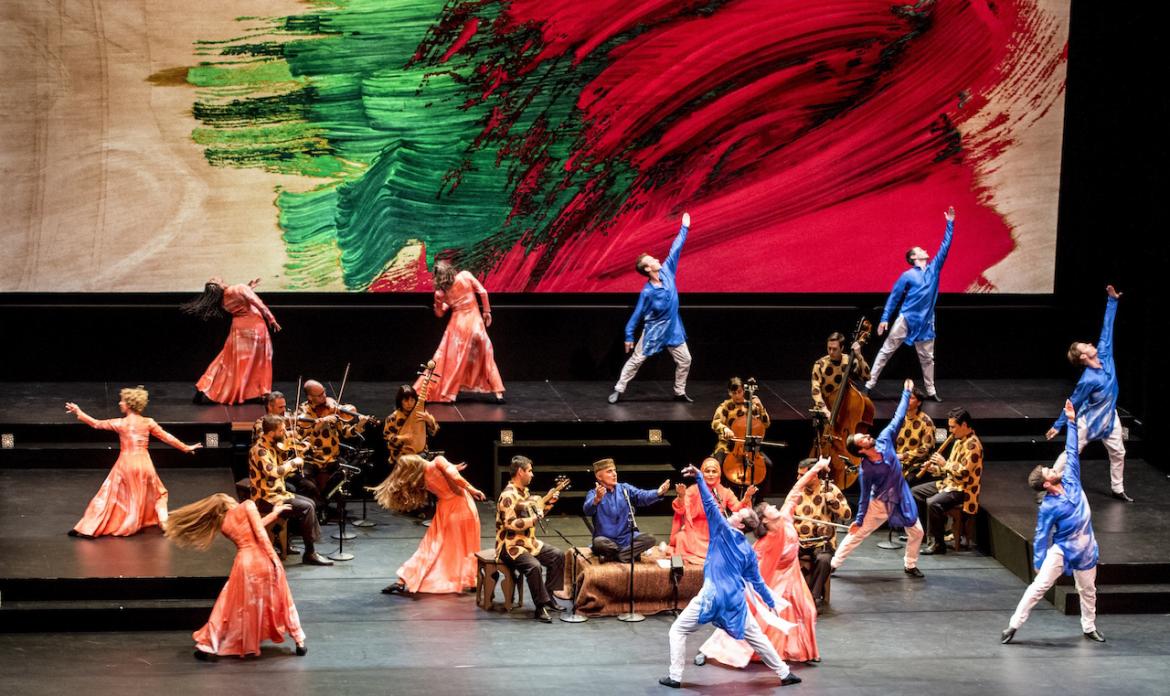Layla and Majnun
Layla and Majnun
17 November 2018
Sadler’s Wells, London
Reviewed by Ken Hunt
Many, maybe most, cultures have tales of star-crossed lovers fated to be separated, sometimes never to get together in the first place, sometimes never to reunite. Tragic romances like Heer and Ranjha and, naturally, Romeo and Juliet pepper everyday language. Their names act as shorthand for lovers kept apart by caste or station, family intrigue or ill fortune – other causes and interventions may apply. They have inspired narrative verse, literature, paintings and motion pictures. Contender for the one that has straddled the biggest number of religious, cultural and linguistic borders is Layla and Majnun. She is often known alternatively as Laili. Qays becomes Majnūn, meaning ‘possessed’ once grief and sorrow prevent him from uniting with his Beloved. Flowing beneath the story is a deep underground stream of mystical, say, Sufi, longing thwarted in uniting with the Divine. Make no mistake, Layla and Majnun is no Mills & Boon love story or Eric Clapton song.
The text chosen for this telling derives from the father of modern Azerbaijani music, the composer Uzeyir Hajibeyov (1885–1948) and his 1908 telling of the tale. It was his first opera and drew on the principles of continuity in change and change in continuity. That fit here. It was fitting that this production, premiered at Zellerbach Hall in Berkeley, California in September 2016, similarly drew on Azerbaijan’s traditional musical bedrock of folksong and mugham. Mugham is the region’s intergrade form that becomes raga by the time the stream reaches India. It was doubly fitting that singing the roles of Layla and Majnun were Alim Qasimov (born 1957) and, in the distaff role, Fargana Qasimova (born 1979). He is, head and shoulders, the greatest living exponent of mugham. Affirming that, in November 1999 the International Music Council-UNESCO Music Prize, nicknamed the ‘Nobel Prize for Music’, was conferred on him. He joined the exalted company of Ravi Shankar, Yehudi Menuhin, Leonard Bernstein, Benny Goodman, and Nusrat Fateh Ali Khan. His daughter has grown (in my opinion) into the foremost, most gifted mugham vocalist of her generation. Colour coordinated with the dancers, their roles were, musically speaking, the constant throughout the hour-and-a-quarter performance.
The static backdrop was a painting by the Hammersmith-born painter Howard Hodgkin (1932–2017) with swirls of red and green brushstrokes. In itself, that was a modernistic statement. In eschewing miniatures – Persian or otherwise – it compared favourably with the distracting busy-ness of the Aga Khan Music Initiative’s Jubilee: Contemporary Expressions of Musical Heritage from the Middle East, West Africa & Central Asia at the Albert Hall in June 2018. Acting out the narrative in dance on a functional stage with three levels of staging blocks was the Mark Morris Dance Group. The two principal roles were shared evenly, a pair at a time, among the ten dancers over the course of Layla and Majnun’s five acts. I–V were titled ‘Love and Separation’, ‘The Parents’ Disapproval’, ‘Sorrow and Despair’, ‘Layla’s Unwanted Wedding’ and ‘The Lovers’ Demise’. While there were what, let’s coin a new word, ‘sidetitles’, as opposed to, say, surtitles, these gave only the most fragmentary or concise of information. Samples: “My heart is broken because I cannot bear being apart from you” and “I feel like a flame burning night and day”. (What I took to be the approved, translated texts were in the programme and therefore lost in darkness.)
The Silkroad Ensemble blended instrumental tonalities such as kemancheh (spike fiddle) and another, similarly emblematic Azerbaijani instrument, the tar lute, and the Japanese end-blown flute shakuhachi, and the Chinese plucked pi’pa lute with Western violins, viola, cello and contrabass. In a sense they were the instrumental foil to the dance. The dance element blended pan-Asiatic dance styles and traditions without any pretence of ‘authenticity’ – whatever that means. There was nothing specifically Azerbaijani detectable in the dance.
Sometimes it’s life’s tragedies, not the happy endings that move us best. That is how best to remember Layla and Majnun. It is a piece to see more than once.
Links
Mark Morris Dance Group Layla & Majnun
Ken Hunt piece 'Alim Qasimov is one of the world’s most masterful singers. I say his name in the same breath as Nusrat Fateh Ali Khan.'
In Concert: Alim and Fargana Qasimov
Kronos Quartet & Alim Qasimov Ensemble - Getme, Getme (Said Rustamov, Azerbaijan)




















